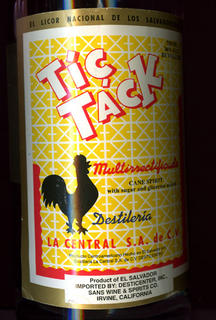De la caña se hace el guaro

Okay, I just did an online search and found almost nothing about Tíc Táck. That's not right. Somebody ought to post something about this stuff.
Tíc Táck is a spectacularly raw liquor that proclaims itself "El Licor Nacional de los Salvadoreños" -- although El Salvador's ministry of tourism neglects to list that distinction along with the national flower (Izote), the national tree (Maquilishuat), and national bird (Torogoz a/k/a Talapo). Maybe one of those would make a better-tasting beverage than this 36% alcohol, clear-as-water rocket fuel. They might as well start with the bird.
Tíc Táck is mostly cane spirit: sugar cane squeezings fermented, then distilled. The generic name for this mass-produced industrial moonshine is "guaro" or sometimes "aguardiente" (literally "ardent water"). And it's very popular -- there's even a song about it:
De la caña se hace el guaro
¡que caramba! sí la caña es buena fruta.
Sí la caña se machuca ¡que caramba!
sí el guaro también se chupa.
From the sugar cane they make the moonshine
Oh boy! yeah that cane is good fruit.
Yeah they crush the cane, yippee!
Yeah, and they suck down the moonshine, too.
(Actually, I find "chupar" translated as "to absorb," but I'm pretty sure they're not saying that they soak their feet in it.)
Fermented distilled cane juice is theoretically the same stuff they make rum out of. But while rum is aged in wooden whiskey barrels for at least a year, Tíc Táck is merely "super filtrado" and "multirrectificado" for whatever good that does, and then, with a little "sugar and glicerine added," squirted straight into the bottle and shipped out the factory door. According to something called "The Ministry of Rum" you ought to age newly-distilled cane liquor because "the ... raw spirits contain small amounts of hydrogen sulfide gas... which gives the spirit a hot harsh taste." And "hot harsh taste" isn't a bad way to describe Tíc Táck. Not enough multirrectificado-ing, perhaps? Maybe the sugar and glicerine is added to keep your mouth from simply bursting into flame.
I was introduced to this product during a stay in El Salvador in the late 1970s, not long before the sad and dreadful civil war that swept the country. Some local friends were hanging around drinking, and they offered me a swig from a small hip-flask bottle. I'm certain that I didn't really have a full-on Roger Rabbit head-turns-purple steam-shoots-out reaction, but whatever did happen must have been humorous enough. Once my eyes cleared, and mis amigos had finished rolling around on the ground in fits of laughter, they explained that they had been mixing theirs into little bottles of Coca-Cola, and then squeezing in some lime.
They informed me that, except in extreme and unusual circumstances (like, say, not having any Coca-Cola), only a complete bolo (drunkard) would actually swig Tíc Táck neat. With that, I realized, we were on the familiar territory, as the heavy sweetness of the Coke nicely blankets that "hot harsh taste" to yield a good (and cheap!) approximation of the rum and cola cocktail still called "Cuba Libre" by those nostalgic for JFK and the early 60s, or perhaps the heady days of the Spanish American War.
The small bottles of Tíc Táck I'd brought home were long gone, and I hadn't seen the stuff anywhere since. Recently though, I fell in with a group of Salvadoran immigrants. We were talking about conditions back home, when I suddenly remembered that dreadful aguardiente with the rooster-silhoutte on the label. "Tíc Táck!" they exclaimed as one. Of course they remembered it.  And did I know? there is at least one store in Cambridge which carries it. And sure enough there is, and they do. A dust-covered 750 ml bottle set me back ten dollars.
And did I know? there is at least one store in Cambridge which carries it. And sure enough there is, and they do. A dust-covered 750 ml bottle set me back ten dollars.
Back in the day, I think those flasks were maybe four or five colones ($1.60 - $2.00 US) in every little tienda and grocery store. These days, the civil war is over and the colon has been retired in favor of the US dollar. But the people of El Salvador still produce and celebrate their licor nacional.
¡Sí, la caña ES buena fruta!

1 Comments:
I´ll try tìc tàck and let me tell you is a Great Drink, becouse, i dont know what this drink have, but the next day i dont feel the hangover. its a great thin and every travel that i make to El Salvador i bring some bottles to home (i live in Guatemala)
Post a Comment
<< Home